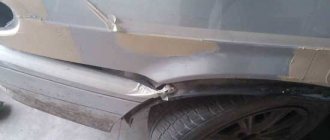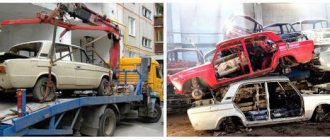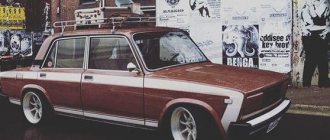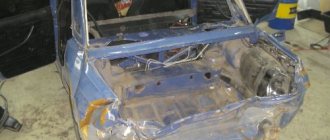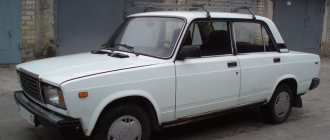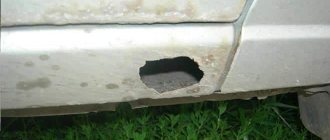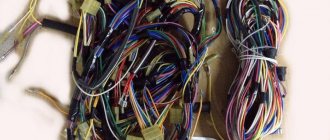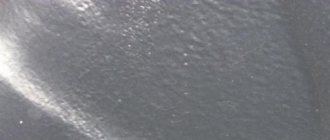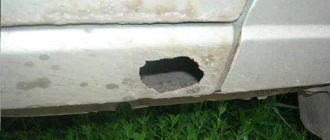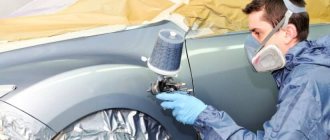To remove rust from a car body, it is not at all necessary to contact a company car service center. Many car enthusiasts can remove small stains of corrosion and chipped paint on the car body, doors or hood with their own hands. Removing rust from the body will extend the life of your car and improve its appearance.
Pockets of rust on the body can appear both from the “aging” of the car, and as a result of careless handling of it. For example, once you open the door carelessly, the chips are right there. It’s unclear what to do about this: repainting a door is expensive, and driving with them is fraught with consequences.
We will tell you how to easily and simply, and most importantly inexpensively, get rid of rust on your car body yourself and reliably protect it from corrosion. At the end of the article , watch a video about removing rust using the most effective and simplest method.
Also on our website you may be interested in the following articles:
- Do-it-yourself anti-corrosion treatment of a car;
- How to treat the underbody of a car against corrosion;
- Removing scratches on a car body without painting.
And so, we propose to consider the main ways to independently remove rust from a car body.
When can you encounter rust?
Metal corrosion, simply called rust, is an oxidative process that occurs when exposed to the environment. A similar phenomenon occurs if the paint on the surface of the car has been damaged. Rust forms as a result of scratches and chips that penetrate into the material over time. The spots spread over a large surface area.
Corrosion spreads faster depending on how aggressive the environment is, as well as the condition of the car body itself. In winter, rust appears faster than in summer.
Important!
If a stain has just appeared and it is a single stain, it is easier to get rid of it. The work becomes more difficult if there are a large number of red spots or the presence of an old stain in cases where the metal has been corroded through and through.
You can judge that corrosion is beginning to appear by the swelling of the paintwork. If a similar phenomenon occurs, you must immediately begin cleaning the surface of the old paint. Subsequently, the affected area is thoroughly cleaned, after which it is necessary to touch up the rust on the car. In this case, you should choose an option so that it completely matches the old paint color.
What is “red disease” and why does it occur?
Car corrosion is the destruction of metal parts of the car body. It occurs due to several reasons:
- Reagents. Salt that gets on metal corrodes it. Over time, red spots appear on the body.
- Terms of Use. Corrosion develops faster in humid climates than in dry climates.
- The driver's attitude towards the car. If the driver rarely washes the car, dirt, salt, and reagents deposited on the metal provoke the appearance of “saffron caps.” Street storage and untimely removal of chips on the body lead to the same consequences.
- The quality and method of processing body materials. Rust develops on non-galvanized metal that has not undergone anti-corrosion treatment.
Corrosion most often appears on the wheel arches, lower edges of the doors, trunk lid, sills and underbody. It also forms in cracks and drainage channels. Sand, dirt, dry leaves get there - and all this prevents the accumulated water from drying out.
Also read: We’ll touch up here, we’ll add oil there: how dealers prepare cars for sale
Where problems appear
Corrosion appears in places that are affected mechanically. The most common problems that arise are:
- First, rust appears on the surface of the thresholds;
- problems often arise with the hood due to small pebbles from the vehicle in front;
- the car underbody suffers from rust;
- Aggressive chemicals negatively affect the area where arched structures are located under the wheels of a vehicle.
Note!
If rust appears in a timely manner and is eliminated, the car owner can prevent further problematic situations. After this, corrosion does not spread.
To cope with the problem, you need to decide how to paint over rust on a car with your own hands.
Content
- What is “red disease” and why does it occur?
- How to remove “saffron milk caps” with your own hands Stage 1. Cleaning the body of “saffron milk caps”
- Stage 2. Puttying the car body
- Stage 3. Body painting
Corrosion is dangerous because it violates the integrity of the body. This makes the car less safe and puts the lives of the driver and passengers at risk.
In this material we will tell you what causes the “red” disease, where it most often appears, how to get rid of it and what cars are affected by it.
How to remove rust
Among the many ways to remove corrosion stains at home, the following are most often used:
- Mechanical. During the work process, remove rust by sanding the surface down to the metal; in difficult cases, use a grinder. Subsequently, the problem area is primed, puttied, and then the repaired area of the car is painted. The advantage of this method is its simplicity. As a result, large and deep stains and damage that are hidden under swelling paint are eliminated. The work is cost-effective; the necessary materials can be obtained without any problems. The disadvantage is the length of the process.
- Chemical. Rust stains are removed using a variety of aggressive products, which are presented in an assortment on the Russian market. Using this method you can get rid of corrosion that has occurred in hard-to-reach places. In this case, the problem is resolved quickly.
Fact!
Do not use chemicals on areas that are very damaged, as this may worsen the problem situation. This can subsequently lead to the vehicle becoming completely unusable.
Now we’ll take a closer look at how to remove and touch up rust on a car using the methods presented above.
Preparation
Before starting work, you should carefully prepare for the process. Before you paint over rust on your car yourself, inspect the entire car, paying special attention to hard-to-reach areas.
Based on the results of the inspection, an assessment is made of the extent of damage to the vehicle and a method is determined for how the corrosion will be eliminated.
It is also necessary to acquire everything necessary for carrying out repair work:
- degreaser;
- sandpaper;
- putty;
- primer;
- paint;
- grinder;
- special varnish for the car;
- anti-corrosion converter;
- masking tape.
Advice!
Don't forget to have a clean cloth ready. With its help, the body is pre-cleaned from dirt and dust particles.
Stages of work execution
Work to eliminate pockets of corrosion on a car body includes several stages:
- the body is cleaned of dirt by washing;
- then it is properly dried;
- carry out an inspection for the presence of pockets of corrosion;
- found rusty spots and stains highlight;
- after this, the body is prepared for work to remove corrosion;
- then the rusted areas are treated;
- the next stage is additional processing;
- after this, all areas must be covered with putty;
- the final stage consists of painting the treated areas.
Elimination of defects mechanically
Problem spots are eliminated mechanically in several stages. The area is thoroughly cleaned down to the metal using sandpaper. You can deal with minor problems yourself. If the area is large, you need to use a grinder or other electric tools.
Clean off rust spots carefully, gradually dealing with the problem. At the same time, be careful not to scratch the body surface.
During work, it is necessary to avoid damaging entire areas of the paintwork. The surface must be cleaned until bare metal begins to appear. After completely cleaning the car, you should treat the problem area using a special converter, which quickly copes with the smallest corrosion residues that are not always visible to the eye.
After applying the converting substance, do the following:
- wait for half an hour until the special converter stops working;
- putty the surface several times;
- sand the treated area;
- Paint the entire car one color, but you need to choose the tone carefully.
For reference!
The adjacent surface must be protected before applying paint. This can be done with newspapers and masking tape.
After applying the protection, an anti-corrosion primer is applied. The substance is used two to three times. Don't forget to dry each layer. A clear varnish is applied over the primer. This will help to reliably protect the vehicle and give it a beautiful appearance.
How effective the process of touching up rust on a car with your own hands will be is determined depending on how the instructions are followed and the work is performed.
Importance of inspection
It is necessary to carefully inspect the VAZ body both outside and inside in order to detect all pockets of corrosion. You need to do this in good lighting so that the slightest spots of rust are visible.
During the inspection, pay attention to the areas most susceptible to corrosion. These include:
- doors;
- hood (especially at the junction with surrounding body elements);
- wheel arches;
- thresholds.
Inside, they inspect the trunk, the back surface of the hood, points under the seats and under the driver’s feet, as well as under the door seals. Also pay attention to paintwork defects. Corrosion often forms on metal elements that are not body parts, for example on a license plate. Therefore, inspection should not be limited to the above-mentioned areas. In cars whose anti-corrosion protection is weak, like VAZ models, as well as in old cars, corrosion spots can be located not only in traditional places. The found points should be highlighted, for which adhesive tape is used.
In preparatory work, in order to avoid damage when treating areas of the body untouched by rust adjacent to rust stains, it is necessary to use protection in the form of covers, awnings or polyethylene.
Correcting a problematic situation using chemicals
After a thorough inspection and identification of problem areas, specialized chemicals are applied to the surface. It promotes the application of rust and prevents its spread. As a result, the metal is not damaged.
In order not to harm the material, it is necessary to carefully apply the substance to the problem area. It should be kept for a certain period of time, after which the product is wiped off or washed off.
If the surface is severely damaged, subsequent puttying, sanding and painting are carried out. Remove stains by applying the following chemicals:
- Car enthusiasts often use phosphoric acid. It quickly eats away rust. A pure substance is usually applied to the surface. But phosphoric acid can be used together with other chemicals. Before application, the chemical is thoroughly mixed.
- Using a special Neutralizer will help you easily cope with corrosion. As a result of applying the substance, rust turns into a dark-colored mass.
- To remove rust, the use of zinc will help. Subsequently, the metal should be galvanized.
- Anti-Rust paste removes visible traces of rust. The substance cannot cope with the source of the problem.
Helpful information
In order for the process of removing rust from the body to be successful, you need to adhere to the following recommendations:
- All work must be carried out taking into account safety precautions. Hands are protected with gloves, and eyes with special glasses.
- When treating the body with caustic substances, you need to take care of high-quality ventilation in the room.
- You cannot keep acid on the surface of the body for too long; it can destroy intact metal.
You can learn about various methods and techniques for removing rust from a car here.
Painting nuances
How to paint over rust on a car is up to everyone to decide for themselves. There are many options. For painting, use a special metal paint of the appropriate tone. Otherwise, it threatens with a large fine from the traffic police.
Paint the entire surface. This can be done manually with a brush. To prevent problem areas from being visible, the vehicle is painted in two or three layers. Experts recommend applying a colorless varnish over the paint.
How to protect your car from the negative effects of corrosion
To protect your car from the negative effects of corrosion, you must do the following:
- wash your car regularly;
- if there are no mudguards, it is recommended to install them;
- treat the car using special polishing agents;
- regularly inspect the car and treat problem areas;
- Remove any small stains that appear in a timely manner.
If the question of how to properly tint bugs and rust on a car is difficult for you, contact specialized auto repair shops. Specialists will conduct a full inspection of the car and help eliminate all problems. The effect will last for a long time. If corrosion is severe, you will have to repair the entire car, spending a lot of money.
